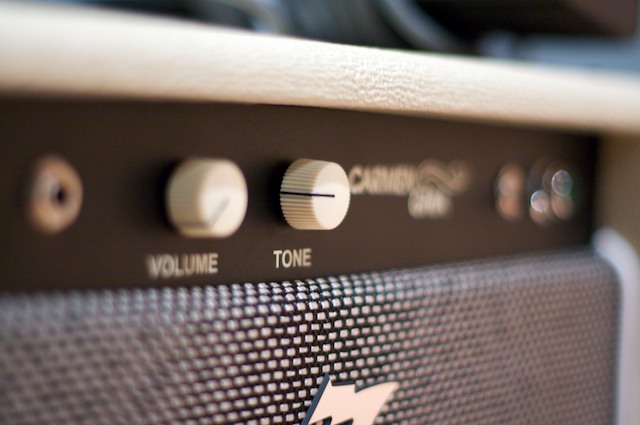
Dr. Z Carmen Ghia
OK, if you’re a guitar player and don’t know these basics, then you deserve Amp Farm™. This is the foundation on how to get and develop your tone.
First, always turn on the power switch and wait for about a minute before switching the standby on. This allows the tubes to heat up a little which will extend their life. Reverse the process to shut down. Never turn an amp on without a load (speakers) or you may damage the output transformer and power tubes. Always match the impedance of the amp with the speaker cabinet.
Basic reasons that guitar amps sound different.
OK, the main reason is the tubes! Distilled down, it’s basically an American sound, like Fender™, or the British sound, like Marshall™. Of course it’s not quite this simple, so stay with me. 6L6 (or 5881’s) are the classic American sound. They sound crunchy, sweet and crisp with a bell-like ‘chime’. This tube has great mid-range tones and distorts very naturally. In contrast, EL34 (or 6Ca7, KT77) are the classic sound of Marshall™ or HiWatt™ amps. They distort easily with a very recognizable bite, compression and crunch. The 6550 is a US tube for domestic Marshalls™ from the 70’s through the 80’s. A little punchier than the EL34’s. Think Ampeg SVT™ tubes. To contrast, 6V6’s are smoother than 6L6’s. They are pushed into distortion easily and have great tone. These are usually found in low power amps. Finally, EL84’s (or 6BQ5) are a British answer to 6V6’s. These tubes distort readily, especially in Class A circuits, with rich, complex harmonic saturation. Think Vox AC-30™.
Speaking of Class A, or AB circuits, it’s not as much as a factor as you would think when it comes to guitar amps. In Class A circuits, one power tube handles all 360 degrees of the output waveform. Class AB divides the waveform into halves (180 degrees each) with one tube (or set) handling the ‘push’ and another handling the ‘pull’. Class A is somewhat less efficient so it may sound ‘juicier’ or more ‘tube’ sounding. Class AB, because the work is shared, is tighter sounding with higher headroom.
Speakers, modern or vintage?
Now, let’s add another set of variables, the speakers. Does size matter? Well, this is rock and roll! Of course size matters!…a, ahem, well, it doesn’t really. Size really has an effect on the attack and response time, not so much on the tone. The time between the pluck of the string and the tone from the speaker is relative to the size. A 10” speaker is very quick and articulate. A 15” speaker is not as articulate with less of an attack. The 12” is somewhat in the middle and therefore is the most common size for guitar cabinets.
Vintage speakers, or low power speakers, usually have a power rating up to 30 watts. American Jensen™ 15 to 30 watt speakers with Alnico magnets have a ‘bell-like’ high end, very open midrange though slightly ‘boxy’, and sometimes ‘farting-out’ on the low end. To contrast, British Celestions™ with Alnico ring magnets sound rich and sweet, very musical midrange tones, nice highs but not a tremendous low end. The ceramic magnet “greenbacks’ are the classic British speaker with plenty of warmth, though gritty and edgy. There isn’t much low end, but when enclosed in a closed-back cabinet it has plenty of ‘oomph’.
Modern speakers, or high power speakers, can obviously handle more power. JBL™’s have a rounded midrange, just a bit of an edge, and sometimes piercing highs. EV™’s are muscular, very balanced and aggressive. They are a little “Hi-Fi” sounding. Celestions™ and Eminence™ have speakers with similar characteristics.
Once you decide upon the basic characteristic of the speaker, then the type of cabinet and cabinet material further enhance the sound. An open back cabinet will further accent the highs. The tone can be broad, quite realistic and very well rounded and transparent. The low end is attenuated just a bit. Open backs appear to be louder because of the omni directional characteristics of the open back. This also makes the cabinets full-throated, gritty and edgy. A closed back cabinet will have a tighter, fuller low end. It will sound more directional with slightly attenuated highs and a ‘spongy’ midrange.
A cabinet with a single speaker will be more focused, while multiple speakers will be slightly blurred due to the natural phase cancellation between the drivers. If the cabinets are made of Pine, or any other solid wood, they will be more resonate, plywood not so much, and MDF stiff and less musical. The final variable is wiring. Wired in series, the speakers will run looser and sound more raw and open. Wired in parallel, the speakers will exhibit a slightly tighter response with a smoother break-up.
Well, that’s it. This is only the beginning for your quest for amp tone. From this Chinese menu you should be able to imagine the sound necessary to fulfill the arrangement, pick and choose the possible tone combinations, add your knowledge of guitars, pick-ups and string choices and what their cumulative effect will be on the amp. I’ll add my knowledge of microphone choice and placement and room acoustics and you end up with killer guitar tones.